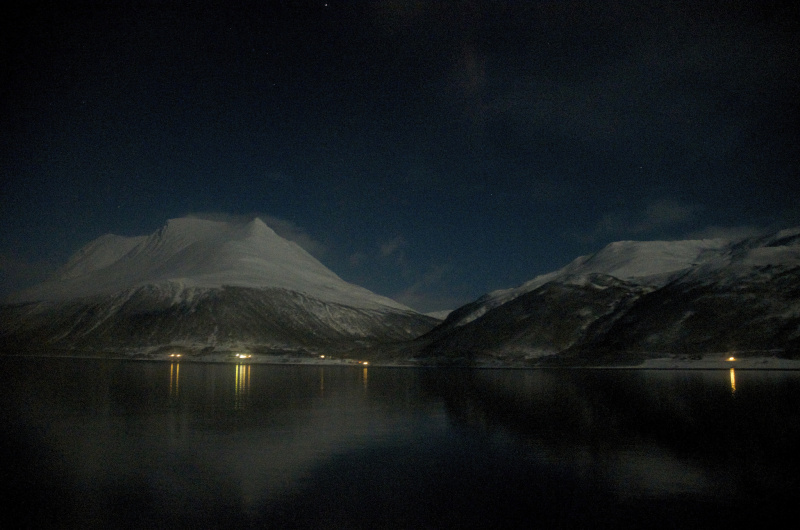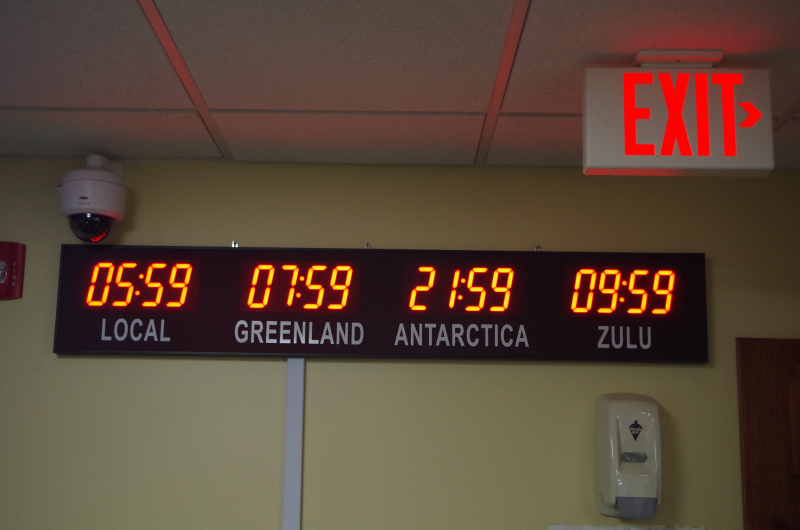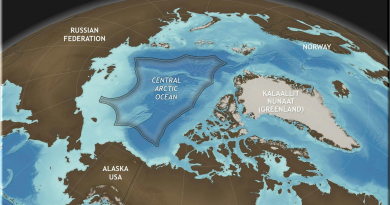Blog: When is it New Year’s at the North Pole?

When December 31 draws to a close, people around the world will welcome in a new year.
Unlike in the summery Antarctic, celebrations in the Arctic will take place under the dark of the polar night with the sunlight of springtime still seeming a long ways away. Big Diomede Island will be the first place in Russia to ring in 2015, but the only people there who might be toasting champagne over their Salad Olivier are soldiers at the military base. The Soviet government relocated all of the island’s indigenous inhabitants, some of whom never saw their relatives on Little Diomede, the island just 2.4 miles across the water in U.S. territory, again. This rocky American outcropping will be one of the last places on earth to say farewell to 2014. The International Date Line is thus another type of border that divides these two neighboring islands, compounding the historical effects of the militarized Russia-U.S. boundary and the “Ice Curtain” of the Cold War, which restricted travel between the two places.
Russia’s time zones
As people in Moscow sip cups of afternoon tea, it will be midnight in Petropavlovsk-Kamchatsky. On the radio during the Soviet era, when the local times would be announced, it would be 3:00 pm in Moscow and, famously, “midnight in Petropavlovsk-Kamchatsky,” a city on Russia’s Pacific coast. Russia’s huge number of time zones has always been a source of pride for the country, but they are far from fixed. Just look at the section on the “History of Zone Boundaries” in Russia on Wikipedia. Currently, there are eleven time zones in what is the world’s largest country. Crimea presented a chronological conundrum when Russia annexed it, for the local time there was +2 GMT (Eastern European Time). This would have burdened Russian timekeepers with twelve time zones. But it was decided that Crimea would, naturally, follow Moscow time, and so no time zones needed to be added. Instead, Moscow made Crimeans mentally adjust to the fact that they would now have what seemed to be two hours extra of daylight in the evenings and two hours extra of darkness in the mornings.
The politics of time
Controlling time is a way for the state to manifest its power. No longer does the sun dictate what time it is: the government does instead. Whole books have been written about this subject, such as Michael O’Malley’s Keeping Time: A History of American Time. Standard time was initially invented by the railroad companies, but it is now a tool of the state. China, for instance, just has one time zone, which The Atlantic recently called “a problem.” India, too, only has one standard time (that happens to be offset by a half hour). Having only one national time is a way to reinforce national unity, while splits in time can divide – Big Diomede and Little Diomede forming a case in point. If people on each island were to look up in the sky at the same time, they would see the sun in the same place. Solar time would essentially be identical between the two islands. But the calendar on Big Diomede would be one day ahead.

Time zones can thus cleave people apart in a similar manner as other types of borders. But there’s one place in the Arctic that doesn’t have a designated time zone, and that’s the North Pole. At this northern extreme where all lines of longitude converge and the line of longitude is a mere point, the sun only rises and sets once a year. No time zone has been assigned to the very top of the planet. So it’s a bit unclear when it will really become 2015 at the North Pole. One could argue at the same time as Big Diomede, or at the same time as Little Diomede, or sometime in between.
For centuries, explorers, entrepreneurs, and more recently geologists have tried to claim the North Pole for their own country. Flags have been planted above and below the sea ice, generating much controversy but no solid claims. The top of the planet still lies outside any one country’s domain and outside any one time zone. The chronological confusion at the North Pole – the fact that no government hotline can be dialed to ask, “What time is it at the North Pole?” – is oddly reassuring. The North Pole remains a place where you can celebrate New Year’s at the same time as people in Rome or Rio, and you won’t really be wrong. Neither Moscow nor Copenhagen nor Ottawa can correct you. The North Pole confounds the confines of state boundaries and time zones. It is literally a place outside time.
So, if you read this sometime on December 31, at 90°N, is it 2014 or 2015? That’s up to you to decide. But you might want to raise a toast when it’s midnight in Petropavlovsk-Kamchatsky.
This post first appeared on Cryopolitics, an Arctic News and Analysis blog.




